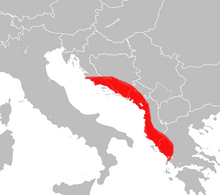| Armadillidium klugii | |
|---|---|
| Scientific classification | |
| Domain: | Eukaryota |
| Kingdom: | Animalia |
| Phylum: | Arthropoda |
| Class: | Malacostraca |
| Order: | Isopoda |
| Suborder: | Oniscidea |
| Family: | Armadillidiidae |
| Genus: | Armadillidium |
| Species: | A. klugii |
| Binomial name | |
| Armadillidium klugii Brandt, 1833 | |

| |
| Range | |
| Synonyms | |
|
Armadillo astriger C. Koch, 1841 | |
Armadillidium klugii is a lesser-known, rare Balkan, Dalmatia-based species of woodlouse, most distinguished by its colouration which resembles the red markings of the Mediterranean black widow Latrodectus tredecimguttatus. This is probably a kind of mimicry, to ward off predators that mistake the harmless animal for a venomous spider.
Due to its red, yellow or white spotting, it is often called the "clown isopod". Insect and isopod enthusiasts usually encounter them being sold as A. klugii Montenegro or variations thereof.
Description
The maximum length of Armadillidium klugii is 21 millimetres, compared to Armadillidium vulgare's 18 millimetres. Unlike the typical black color of the dorsal plates of most Armadillidium species, the base coloration of A. klugii is greyish brown, and has three rows of white dots running front to back. As they age, the center row turns yellow. These pale spots are for mimicry of the Mediterranean black widow, which has similar rows.
Distribution
The range of Armadillidium klugii lies along the coastline of the Adriatic sea, spanning from Croatia to Montenegro. The majority of A. klugii records are clustered in Dalmatia, in the northern end of its distribution, but 5 specimens have been reported in south Albania and west Greece. It is found under stones and in crevices.
References
- "Armadillidium klugii Brandt, 1833". Integrated Taxonomic Information System. Retrieved July 29, 2015.
- ^ Schmalfuss, Helmut (2013). "Revision of the Armadillidium klugii-group (Isopoda: Oniscidea)" (PDF). Stuttgarter Beitr. Naturk. A, Neue Serie. 6: 1–12. Archived from the original (PDF) on 2017-04-07. Retrieved 2015-07-29.
- Helmut Schmalfuss (2003). "World catalog of terrestrial isopods (Isopoda: Oniscidea) — revised and updated version" (PDF). Stuttgarter Beiträge zur Naturkunde, Serie A. 654: 341 pp. Archived from the original (PDF) on 2009-02-24. Retrieved 2015-07-29.
- LLC, New England Herpetoculture. "New England Herpetoculture LLC". www.neherpetoculture.com. Retrieved 2020-02-24.
- "Isopod Care & Info".
- Levi, Herbert (1965). "An Unusual Case of Mimicry". Evolution. 19 (2): 261–262. doi:10.1111/j.1558-5646.1965.tb01714.x.
External links
| Taxon identifiers | |
|---|---|
| Armadillidium klugii | |